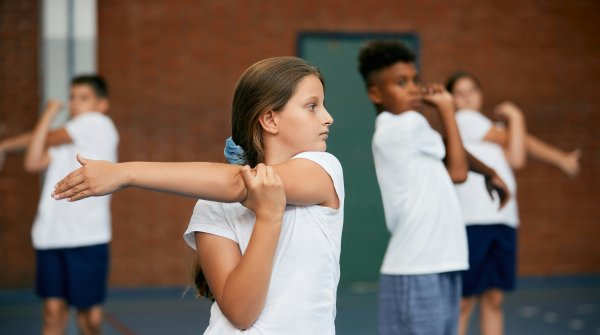What is Mobility?
It describes the extent to which you can stretch your muscles and ligaments without pain or injury. So a mobility workout makes your body more supple, resilient, and stronger too! It includes a variety of exercises that you can do at any age and fitness level - and in any location.
Many strength athletes rely on slow, intensive stretching to prevent hardening or adhesion of the muscles during training. And even office workers who move very little throughout the day are discovering the beneficial effects on typical problem areas such as the back, shoulders or neck.
A Mobility sports session consists of stretching, myofascial self-massage and muscle strengthening. It is therefore much more than a warm-up workout or classic stretching, but is considered beneficial for the entire musculoskeletal system.
Mobility can be divided into the following three phases:
Stretching is a further development of the classic stretching of the so-called passive musculoskeletal system, i.e. the tendons and ligaments. Because smoothly functioning movements minimize the risk of injury or tension!
Therefore, you usually feel the effect quickly and clearly! Especially typical annoying everyday problems like back pain, neck tension or stiff shoulders are suddenly history.
Myofascial self-massage is the treatment of muscles and fascia by applying pressure to them.
In most cases, a so-called fascia roller is used. This is a special firm foam roller that you place on the floor and then roll different areas of the body over it. This sounds fun at first, but unfortunately it feels hard and uncomfortable the first few times. But it's worth biting through, because you'll soon get used to it and start to feel the loosening effect.
By rolling, your muscles and fasciae are stretched out, so that tensions, conglutinated muscles or hardenings are loosened. In addition, it stimulates blood circulation, which is why you usually feel an increasing warmth in the area.
Massage balls are also popular equipment for myofascial massage. The spiky rubber balls come in different sizes and hardness levels and can also be used for a mutual couple massage.
However, myofascial self-massage is not for everyone. If you have circulatory problems or even clotting disorders, severe injuries or acute inflammation, this part should be out for you. Otherwise, your health condition might even worsen.
For optimal, rather than just painful, use under physiotherapeutic guidance or with a fitness trainer is recommended anyway. Especially with equipment with very strong pressure, there is also a risk that you will injure yourself. To be on the safe side, always talk to medical personnel or physiotherapists about your limits and goals beforehand.
As it were, muscle strengthening also happens alongside all the exercises. Many of the poses require a high degree of body tension and thus give the muscles a strong boost.
Since Mobility works primarily with your own body weight, each exercise is always also a light strength training that addresses and challenges different muscles.
Warming up is always on the program at the very beginning of the session. Even though mobility is all about flexibility and suppleness, it is still advisable to loosen up and prepare the body and muscles at the beginning.
The first few times, by the way, you should definitely go to work under the eyes of a professional. Most people don't know their limits very well and quickly overestimate or underestimate them, which can lead to serious injuries if you're too ambitious. Expert trainers will guide you on how far you can go and help you develop a better feeling for your body.
For strength athletes who want to use mobility in addition, small sessions before each training session are particularly suitable, which they combine with larger mobility workouts every few times. This way, the different approaches complement each other perfectly!
But also in the morning as a jump start, after hour against office stress or in the middle of the lunch break, small workouts can be accommodated well. But don't forget to include longer workouts on a regular basis to stay effective.
Many exercises in Mobility Workouts are well-known classics that have a reliable effect. Squats that work the joints in your hips and knees, shoulder circles for healthy posture without tension, and cat bends for a pain-free back after all that sitting at your desk - all of these exercises are easy to do and you've seen them before.
Mobility plays an important role in a low-injury musculoskeletal system. Good flexibility and mobility help you avoid injuries, relieve pain and allow for full relaxation.
After all, if your flexibility is limited due to stuck muscles, unhealthy postures or tension, this will also become a problem for your joints, fascia and muscles in the long run.
Especially people who move little in everyday life due to their job or sit rather uncomfortably, powerful strength athletes or people with weakened ligaments and tendons or joint problems benefit enormously from a training focused specifically on these goals. Just a few units make a noticeable difference in everyday life or workouts - even if it is often a little uncomfortable at first to activate and feel the entire musculoskeletal system.
Mobility workouts invite you to think of them more as a warm-up program before weight training or cardio workouts. However, they should be considered a training program in their own right and should be taken seriously. Although it is a great combination to do mobility exercises before intense, exhausting workouts, there should always be regular days where the focus is on mobility content.
To avoid risking injury from over-ambition or incorrect movements, a training plan should always be created or discussed with trained professionals. It's also best to have your family doctor check you out beforehand or talk to a physiotherapist about your body and any limitations or weak points.
It is important not to throw in the towel too quickly. Although you usually notice the first effects very quickly when your back no longer hurts and your body seems to be more flexible, this should not lead to a too rapid increase in demands or a neglect of care during the exercises. Have patience and use the workout also as a deceleration in your life. If an exercise is causing you pain, rather let caution prevail and see the journey as the destination - but also don't give up just because you don't like an exercise.
Last but not least: You are training for you and with you. Don't compare yourself with the flexibility of others and don't strive for too high an ideal. Flexibility depends on many factors, not all of which you can influence. Concentrate on yourself and your body feeling!
Since weight training has discovered Mobility, more and more gyms offer entire courses or workshops on the subject. Often they simply integrate it into their other courses, because mobility is a supplement for every sport.
If you know your way around or have been well instructed by a fitness trainer you trust, you can of course do the exercises at home, in the office or even in the park in the most beautiful sunshine. Except for a fascia roller or a massage ball you don't need any equipment, so you can do your exercises anytime and anywhere.
As a tip: Even if you are sure that you are doing the exercises cleanly and healthily, you should involve professionals every now and then. They can show you new workouts, correct minor mistakes, and raise your standards as high as is reasonable for your health.
- ISPO awards
- Mountain sports
- Bike
- Design
- Retail
- Fitness
- Health
- ISPO Job Market
- ISPO Munich
- ISPO Shanghai
- Running
- Brands
- Sustainability
- Olympia
- OutDoor
- Promotion
- Sports Business
- ISPO Textrends
- Triathlon
- Water sports
- Winter sports
- eSports
- SportsTech
- OutDoor by ISPO
- Heroes
- Transformation
- Sport Fashion
- Urban Culture
- Challenges of a CEO
- Trade fairs
- Sports
- Find the Balance
- Product reviews
- Newsletter Exclusive Area
- Magazine





